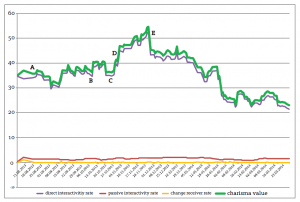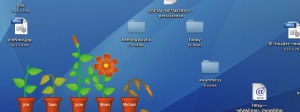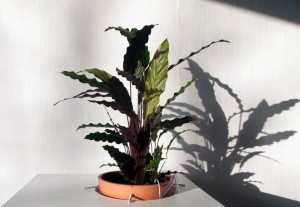Plants as a barometer: “Charisma Garden”
The last introduced projects were characterized by its approach of attaching data to a plant. In this project “Charisma Garden” (2013 - 2014), the data will be directly integrated in the health and growth process of a plant. In comparison to the “Travelling Plants” and “Dead Tree Project”, the data is not added to the plant then rather the representation of the data is the plant by itself in this project. In relation to the chapter “3.1. Visualizing techniques with plants” on page 44, the “Charisma Garden” project can be assigned to the category plant displays and takes over the role as a data sculpture. This dynamic (visually changing) data sculpture presents the social activity of a Facebook user.
Background and motivations
In the 20th and 21th century, the knowledge and information explosion displaced the irrational topics and its behaviours. Our current life style is driven by rational decisions and appropriate behaviour towards certain defined goals [Lenze2002, page 107]. After all advantages of this development, unfortunately it has a depersonalised impact on the human mind [Lenze2002, page 138]. Nowadays, the humans start to crave for emotions and new experiences. The domains of art, erotic and politics are supposed to provide these kinds of human desires [Lenze2001, page 116]. Furthermore, people also have a strong aspiration for identity. They want to experience and shape their own identity. This desire is well recognized through expressions on online social media applications (e.g. Facebook). Some activities results in very odd communication behaviours. Anitra Eggler described some of these odd actions in her infotainment written-style book about bizarre Facebook habits [Eggler2013]. Beyond media specialist, also media artists deal with this topic. For instance, the media artist Jonathan Harris criticise complains against interaction designers and software developers. In his essay “Modern Medicine” (2012) he described how current social media is designed to be addictive. He demands that the current software developers should take responsibility to change this and work stronger in considerations of ethical attitudes.
The project “Charisma Garden” addresses this potential addiction problems with social media and the experience of the own identity. In Japan the own personality can be expressed and visualized through a bonsai tree [Shoemaker2002, pp. 175-178]. A bonsai tree in a healthy condition represents a good personality. In contrast, a bonsai tree in a bad condition symbolises a bad personality or at least that something is wrong. In our cultural context, the relationship between humans and plants weakened, although the emotional connection to plants still exist [Flagler1994, page 4].
The motivation of this project is to emphasize the relationship between human and plants. Another strong focus for it is to enable an emotional experience of an identity. The plant is the physical object and presents the identity similar to the Japanese culture. Instead of maintaining the plant by a human, the “Charisma Garden” system cares for the plant through connected water pumps and additional fertilizer by itself. This system is influenced and controlled by the social activity of a Facebook user. The social activity is measured by a social media performance metric approach. Depending on the results an algorithm decides how much water and fertilizer a plant gets. The installation “Charisma Garden” takes over a barometer function for a harmonic Facebook usage.
The term charisma
In colloquial language the term charisma is related to a person that has a positive impact and impression on other people. The phenomena charisma is strongly connected with an expression of the own identity. Unfortunately, this colloquial scope of charisma is very wide defined and the word itself is used in many various contexts. Therefore it is very difficult to determine the phenomena charisma exactly. Philosophers and social scientist prefer to avoid the term charisma. The meaning is too diffuse for them [Lenze2002, page V].
From a Greek history point of view, the phenomena charisma is better to understand in a pragmatic context. In the ancient Greek culture the Charites, people with a huge charisma, were responsible for social welfare and happiness [Hausermann2001, page 71 and 72]. The Greek society enjoyed spending time with these charismatic people a lot. Nowadays, the history of Charites is not well known anymore, nevertheless the society still loves spending time with charismatic people. The pop culture and the excitement for celebrities are an indicator for this phenomenon. The “Charisma Garden” installation intends to help Facebook users to become a better charismatic person. In that relation my hypothesis points out that more charismatic people increase the social welfare and the society benefit from it.
Moreover, the charismatic impact was an indicator for the success of an ancient Greek speech. A successful speaker, a charismatic person, was able to encourage the listener’s feelings of shocks and excitement [Hausermann2001, page 79]. The image of a charismatic speaker changed in a bad context during the 20th century. The German leader Adolf Hitler is associated with this kind of a charismatic speaker and person. Despite of this negative context, people still have the desire for excitement talks (e.g. TED Talks). The “Charisma Garden” is designed to be a component in re-experiencing the positive impacts of charisma on people and society.
Nevertheless, it is still a strong discussed phenomenon. The USA politicians and the mass media experimented with the phenomena charisma and made some negative experiences [Hausermann2001, page 81]. The durability of the charismatic impact is very difficult to maintain and therefore questionable. According to Malte Lenze, this kind of staged charisma loses its constancy, because the personal connection decreases after time. This weakening effect has a negative impact on the maintenance process of the staged charisma activities [Lenze2002, page 141]. The project “Charisma Garden” deals with the weakening effect of the personal charisma connection. The plant is supposed to be a tangible and visual artefact for representing the personal charisma and to support the emotional connection to the personal charisma. The investigation on how strong the “Charisma Garden” influences the individual Facebook user and its communication behaviour is beyond the time scope of this thesis.
Social media metrics for calculating charisma
Max Weber described the phenomena charisma as a social construct [Hausermann2001, pp. 22]. The charisma of a person is based on the three parts inherent charisma, learned charisma, and charisma from external sources.
The inherent charisma is difficult to measure on Facebook. It is closely connected to the individual experience of the person. That includes the visual appearance as well as character attributes like hobbies and interests. In relation to the “Charisma Garden” project, the system analyses the number of friends and how the count changes over time for determining the inherent charisma. The metrics are adapted from the “Fan Growth Rate” of the social media metrics tool quintly.
The learned charisma can be assigned to the communication behaviour on Facebook. The value of Facebook messages and post differs. An individual is able to learn the efficient communication techniques. That means dealing with topics that are more or less interesting for the receiver group [Hausermann2001, page 26]. Sometimes the communication and its content are contradictory to each other. This is not necessary a problem, it can emphasize the authentic and unique experience of a person. The impact and the rate of attention a post receives are measurable. The social media metric “interactivity rate” reveals this performance of a post. In our case the calculation uses a fixed time interval of the last 90 days:
The influence on charisma from external sources is very limited. The development of this charisma is not linear. Over time it will be an up and down. Fortunately, in this case the Facebook platform enables a simple tracking of these changes. Mentions in posts and the number of posts from others on the Facebook user’s wall are the metric units in that relation. The resulted metric of this external source is called “passive interactivity rate” and is calculated as followed:
The final charisma value is a summary of these three metrics. All three values are added together and determine the charisma on Facebook in one number value.
The next process is the transformation of these values in the life cycle of the plant.
Attributes and implementation of the plant display
The “Charisma Garden” project is a plant display as it was previous described in chapter “3.1. Visualizing techniques with plants” on page 44. The difference between the “Charisma Garden” plant display and the other plant displays is its circular interaction design. The approach of visualizing the information with a plant is very similar to the “Plant Display” by Satoshi Kuribayashi and Akira Wakita [KuriWak2006]. The “Charisma Garden” also analyzes and visualizes human communication behavior, except the user’s reaction is differently implemented. The user analyzes the appearances of the plant and adapts his communication based on the plant appearance. Once more changes in the user’s communication influences the appearance of the plant. Similar to the computer vision rendering of the “Social Garden” (2009) developed by John Kestner [Ars2010]. In that relation we can speak of a closed interaction circle.
Furthermore, every plant has its own specific behavior based on the environmental conditions and the seasonal changes. This emerging diversity in plant behavior and appearance adds an additional interpretations level for the user. The experience of his own identity through the plant will be influenced from these external influences. No current technology exist that adds this kind of unique randomness factor. Moreover, it makes each “Charisma Garden” plant display exclusive and authentic. The comparison of the development of each garden is in that relation much more difficult. This phenomenon is not a problem. It is actually my intention, because it transforms the quantitative results from the charisma analysis to a qualitative system. The number values disappear and the visual appearance of the plant is interpreted individually by each human. Another important purpose that his circumstance provides is the idea that every human is unique. An information visualization of the charisma on a computer screen enables people to compare each other. The result will be a competition as it is observable within the social media tools Klout. The goal of the “Charisma Garden” project is to provide an irrational access and experience for individuals to perceive their own identity through a physical sculpture. It is supposed to be life enhancement tool as the Bonsai is used for older adults in Japan [Shoemaker2002, pages 175-179].
Technically the “Charisma Garden” is implemented with an Arduino circuit and program. The Arduino is connected with an own created web service that calculates the charisma values. Depending on the quantitative charisma analysis the Arduino controls the water and fertilizer supply. If the charisma value is high, the plant gets the best treatment. In our case it means serving the appropriate amount of water and fertilizer, which the plant currently needs. If the charisma value is mid high the plants gets as enough. Fertilizer will be given only in a few weeks rhythm. When the charisma value is low, the water supply for the plant will be less to none existing. The plant is able to deal with this bad condition for a short time. After a longer period the individual has to change his communication behavior on Facebook for improving the plant’s condition. This communication behavior change can be caused by increasing the amount of friends or by writing some new posts or messages on Facebook. The last activity influences the direct interaction rate, which is mostly the simplest approach to boost the charisma value. It also has the side effect that friends pay more attention for the Facebook user and even start to communicate with him or her. This reaction can increase relationships between people and that influences the social welfare.

First version of the prototyp table with a spider plant. The electronics are fixed on the top of the table. The water reservoir and the pumps are arranged underneath.
One exception case is implemented in the “Charisma Garden” installation. If the charisma value is low and the number of own post is high in contrast to a low direct interactive rate, the systems assumes that the information value of the individual communication behavior is low. The system believes that the Facebook user spams his friends with useless information. The reaction of the system will be resulted in an excessive water supply. The plant will be damaged from too much water like your friends suffer from the too much useless information sent by the individual. In that context the barometer function of the “Charisma Garden” becomes obvious. The intention of this exceptional case is to experience the overload of information that is easily created and should be avoided. Friends and the society will be grateful for it.
Findings and results
The quantitative analysis of the charisma represents fairly accurate my communication behaviour on Facebook. During time periods with many sent messages and feedback in form of likes and shares, the charisma value increased continuously. These peaks were particularly noticeable when I posted my results of the artworks “Travelling Plants” and “Dead Tree Drop” on Facebook. The time period between the end of 2013 and the beginning of 2014 the charisma value decreased significantly. This decline is related to the almost none existing communication on Facebook while I wrote my thesis (see figure 120).

The chart shows the monitoring of my charisma from August 2012 to March 2014. At point “A” I informed my friends about the “Travelling Plants” project. The letter “B” marks the time when I updated my friends about the research results and my attendance as a speaker at the WCOMTC symposium. The “Dead Tree Drop“ project were posted on Facebook at point “C“. Directly afterwards I wrote about the outcomes of my Game Design workshops, which is visible at marker “D“. In the beginning of December I started writing my thesis and the charisma started to decrease at point “E”.
The visualization of the charisma values through a plant got disturbed by technical problems. In some cases the connection between the Arduino and the webserver caused a crash of the Arduino software. After a while I figured out that the used Arduino Uno is not the appropriate microcontroller for this kind of application. In consideration to the limited hardware capabilities of the Arduino Uno, the new released microcontroller Arduino Yún with an embedded Linux Kernel for REST webservice meets my requirements much better and might be a solution for the future.
Regarding to these technical problems, the charisma value could not be accurate synchronized with the plant’s lifecycle. Therefore an investigation in changing communication behaviour caused by the “Charisma Garden” installation could not be processed. A research in this field is a goal for future activities and presents the work in progress state of this project.
Nevertheless, the “Charisma Garden” installation was easy to include in the everyday living environment. The plant beautified its habitat and caused curiosity of visiting friends. The electronic circuits, pipes, and the sensors could be hidden very well. For this reason, the installation fulfilled my expectations of a harmonically integrated Human Plant Interface.
References:
[Flagler1994] Flagler, J. & Poincelot, R., (1994). People-plant relationships: setting research priorities. Food Products Press, 1994.
[Hausermann2001] Häusermann, Jürg (2001). Inszeniertes Charisma: Medien und Persönlichkeit. Niemeyer, 2001.
[Lenze2002] Lenze, Malte (2002). Postmodernes Charisma: Marken und Stars statt Religion und Vernunft. Deutscher Universitätsverlag, 2002.
[Shoemaker2002] Shoemaker, C. A. (2002). Interaction by Design: Bringing People and Plants Together for Health and Well Being. John Wiley & Sons, 2002.
[KuriWak2006] Satoshi Kuribayashi and Akira Wakita (2006). PlantDisplay: turning houseplants into ambient display. In Proceedings of the 2006 ACM SIGCHI international conference on Advances in computer entertainment technology (ACE ‘06). ACM, New York, NY, USA, , Article 40.
[Ars2010] Stocker, Gerfried; Schöpf, Christine (2009). Ars Electronica 2009 – Human Nature. Exhibition catalogue, Hatje Cantz, 2010.
[Eggler2013] Eggler, Anitra (2013). Facebook macht blöd, blind und erfolglos: Digital-Therapie für Ihr Internet-Ich. Orell Füssli, 2013.







The Dutch media artist Sander Veenhof translates attention from social media plattform into the grow process of a plant. His plant display Publicity Plant (2009) analyzes the feedback from online social media plattforms gives feedback of the monitored data (plant health data, soil moisture and light supply). In this context it holds strong connections to my above described project Charisma Garden.
Another very helpful tool for the Charisma Garden in consideration of the plant’s growing process are those Origami Pots. This approach enables the plant to grow almost in any size. If the charisma grows very big (for instance becoming very famous or entering a Celebrity state) the plant pot will not limit the plant growing. More information is available here:
Shape-Shifting ‘Origami’ Pots That Grow Together With Your Plants
The technical implementation could be solved also with a Raspberry Pi and the Grove Smart Plant Care Kit by Seeed Studio. A shield for the Raspberry Pi is delivered by Dexter Industries.
http://www.seeedstudio.com/wiki/Grove_Smart_Plant_Care_Kit
http://www.dexterindustries.com/grovepi/
For measuring the plant health, we can use an infra red camera for the Raspberry Pi
https://www.adafruit.com/product/1722
https://publiclab.org/wiki/infragram
https://publiclab.org/wiki/multispectral-analysis-for-determining-plant-health
http://greenstemnetwork.org/next-step-spectral-analysis/
On hackster.io James Thomas wrote a very nice tutorial about smart garden, which can be adapted for the Charisma Garden project:
Solar Powered, Remote Controlled, Smart Garden with Raspberry Pi
The previous chapter about growable media and plant display introduced already the application of light to plants. This article observes the growing pattern of different LED lights on plants:
Einfluss der verschiedenen Wellenlängen einer LED-Belichtung auf das Pflanzenwachstum
https://www.hswt.de/forschung/wissenstransfer/2013/april-2013/belichtung.html
Sensors like this one can help to measure how effective the natural light is and if it needs some more additional light:
GRV SUNLIGHT :: Arduino – Grove Sonnenlicht-Sensor v1.0 measure wavelength from: 280 … 950 nm, which is more than enough for plants
https://www.reichelt.de/Weiteres-Zubehoer/GRV-SUNLIGHT/3/index.html?ACTION=3&LA=2&ARTICLE=191223&GROUPID=6671&artnr=GRV+SUNLIGHT&SEARCH=%252A
Smart Garden Tools for bigger plant installations
http://www.gardena.com/de/produkte/smart/smartsystem/
Another example of an Automated Garden/Plant project with the Raspberry Pi
Hacker House’s Zero W–powered automated gardener
https://www.raspberrypi.org/blog/hacker-house-automated-gardener/
Another great documented automated Plant Project
GreenPiThumb: A Raspberry Pi Gardening Bot by @JeetShetty and @mtlynch
https://mtlynch.io/greenpithumb/
http://greenpithumb.mtlynch.io/
https://github.com/JeetShetty/GreenPiThumb
Schöner langer Artikel über Charisma von Silke Weber in der Zeit (2018)
https://www.zeit.de/zeit-wissen/2018/03/charisma-ausstrahlung-auftreten-gestik
Plant-DiTech is a company that focuses on understanding stress responses, such as water and nutrient stress. They have a phenotyping platform and analysis software to monitor plants and understand complex data sets.
https://community.plantae.org/article/5015998422524626857/plant-ditech-functional-phenotyping
http://www.plant-ditech.com/